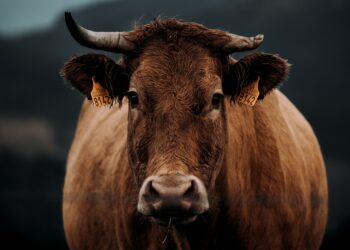
More than a century ago, archaeologists digging at Stonehenge uncovered a cow’s jawbone. It was placed deliberately beside the monument’s south entrance, dating to the very dawn of its construction around 2995–2900 BCE. For decades, it was just another strange detail in a site already overflowing with mysteries, myths, and legends.
Now, thanks to cutting-edge chemistry and a sliver of that cow’s tooth, researchers believe this animal may carry the story of how Stonehenge’s massive 20-ton bluestones were dragged 125 miles from Wales to Salisbury Plain.
A Six-Month Diary Written in Enamel

Researchers at the British Geological Survey, Cardiff University, and University College London sliced the cow’s third molar into nine layers of enamel. Each layer preserves chemical traces from roughly six months of the animal’s life like a molecular diary. Oxygen isotopes revealed the seasonality of tooth growth — beginning in the depths of winter and ending in midsummer. Carbon isotopes traced the cow’s shifting diet, from nibbling on woodland fodder in cold months to grazing open grasslands in summer.
But the real breakthrough came from strontium and lead isotopes. Strontium revealed where the cow’s food had grown, while lead sourced from old Paleozoic rocks offered a deeper signature locked in bones and released during physiological stress. Together, the two signatures rule out most of southeast England and point toward Wales, where this type of rock is prevalent. Another supply of such rocks is found in the Lake District and Scotland. One thing’s for sure, this ancient cow didn’t grow up on Salisbury Plain.
“It must have been grazing at some time on older rocks,” Professor Jane Evans of the British Geological Survey told The Guardian, “and the obvious conclusion, given it’s Stonehenge, is that Wales is the probable origin of the cow’s early life.”
If true, this cow — or at least her remains — traveled over 100 miles across Neolithic Britain. And she didn’t do it alone.
Cow-Powered Megalith Transport?
Stonehenge’s famous bluestones — some weighing over four tons — have long been traced to quarries in Wales. But what we haven’t known is how they made the journey. Enter the cow.
Professor Michael Parker Pearson, one of the study’s co-authors and a leading figure in British prehistory, finds this new evidence compelling. “It raises the tantalising possibility that cattle helped to haul the stones.”
Here’s where things get very interesting. Until recently, archaeologists assumed cattle in this period weren’t used as beasts of burden. But new studies, including this one, challenge that idea. Some cattle bones show foot structures consistent with heavy load-bearing. And placement of this cow’s remains — carefully buried at the ceremonial entrance to the earliest version of Stonehenge — suggests she wasn’t just dinner.
“If you’re dragging rocks the size of a minibus from Wales to Wiltshire,” Evans noted, “you need more than muscle — you need a support network. You’ve got to feed people. Feed animals. Coordinate logistics across the landscape.”
This is Neolithic project management — and cows may have been central to the plan.
Pregnancy, Isotopes, and The Stonehenge Cow’s Final Months
The cow’s tooth revealed something else: she was probably female. This may matter more than you think. During pregnancy or nursing, cows undergo metabolic stress, and bones release stored elements like lead back into the bloodstream. That lead ends up in teeth.
And sure enough, one enamel layer — formed in late winter to early spring — showed a lead isotope spike inconsistent with anything in the surrounding environment. It matched older, Palaeozoic lead signatures mentioned earlier. That’s consistent with a biological event like pregnancy pulling the lead from her bones into the developing tooth. So, to test this hypothesis, the team performed peptide-based sex determination, a technique originally developed for forensic crime labs.
“This detailed biographical approach on a single animal provides a brand-new facet to the story of Stonehenge,” Richard Madgwick, a professor at Cardiff University and lead author on the study.
A Monument Built on Bones
Another interesting tidbit is that the cow likely died years before she — or at least her jawbone — was buried at Stonehenge. Radiocarbon dates suggest her remains could’ve been curated for decades, maybe even centuries. Whether she was eaten, ritually buried, or carried as a relic of the journey, we may never know.
But the deliberate placement of her jaw at the gateway to Stonehenge’s first ring speaks volumes.
In the end, one cow’s six-month molar snapshot becomes a keyhole into a broader story. Stonehenge was most likely not just built by humans.
The enormous labor required to haul bluestones from the Preseli Hills to Stonehenge would have demanded strong animals, food supplies, and coordinated human networks. Excavations around the outcrop have uncovered the remains of man-made platforms of stone and Earth. Archaeologists also suspect that the builders used ropes and levers.
Michael Parker Pearson of University College London described the finding as “yet more fascinating evidence for Stonehenge’s link with south-west Wales… It raises the tantalising possibility that cattle helped to haul the stones.”
“A slice of one cow tooth has told us an extraordinary tale and, as new scientific tools emerge, we hope there is still more to learn from her long journey,” Evans said.
The findings were published in the Journal of Archaeological Science.






